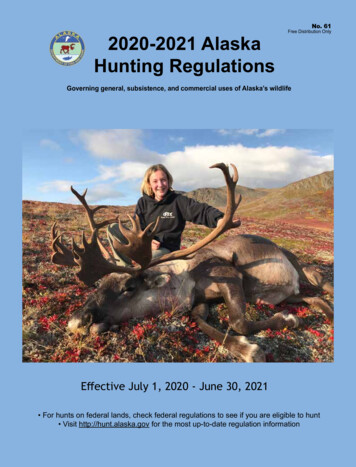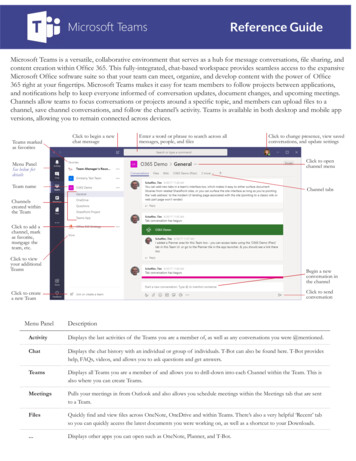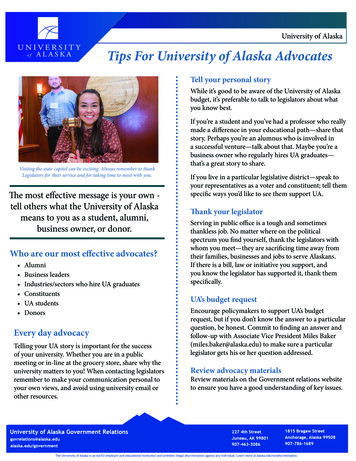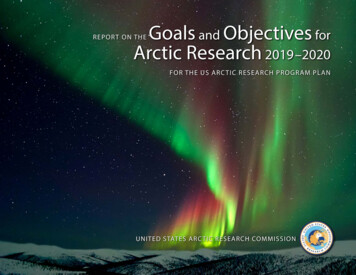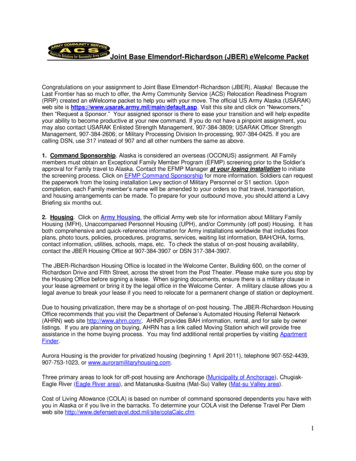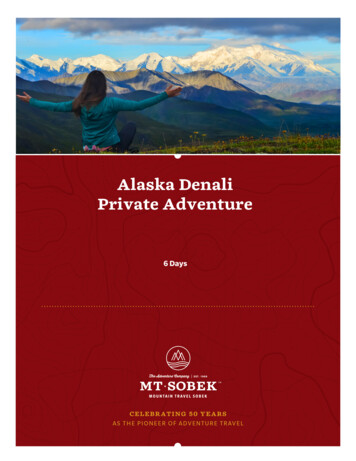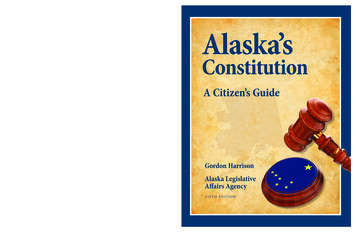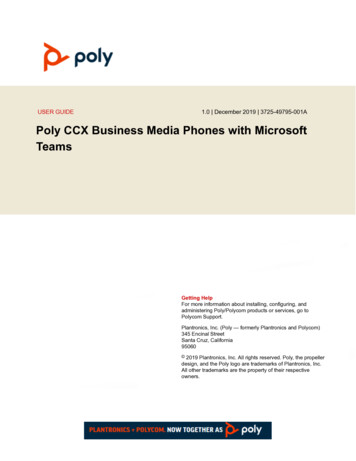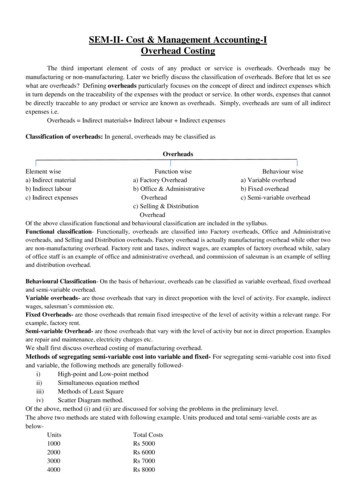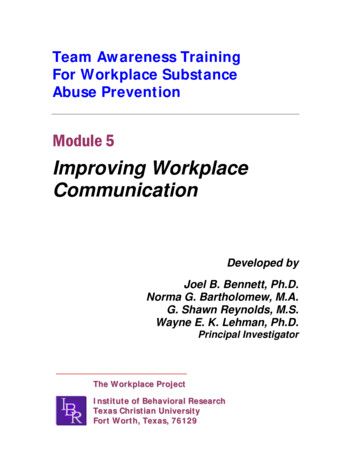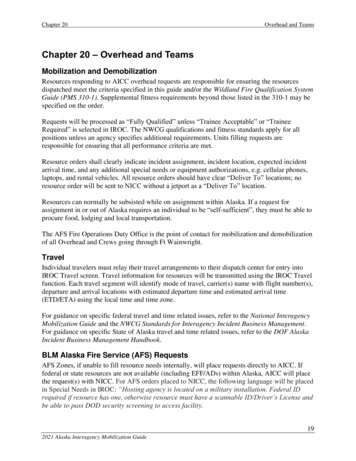
Transcription
Chapter 20Overhead and TeamsChapter 20 – Overhead and TeamsMobilization and DemobilizationResources responding to AICC overhead requests are responsible for ensuring the resourcesdispatched meet the criteria specified in this guide and/or the Wildland Fire Qualification SystemGuide (PMS 310-1). Supplemental fitness requirements beyond those listed in the 310-1 may bespecified on the order.Requests will be processed as “Fully Qualified” unless “Trainee Acceptable” or “TraineeRequired” is selected in IROC. The NWCG qualifications and fitness standards apply for allpositions unless an agency specifies additional requirements. Units filling requests areresponsible for ensuring that all performance criteria are met.Resource orders shall clearly indicate incident assignment, incident location, expected incidentarrival time, and any additional special needs or equipment authorizations, e.g. cellular phones,laptops, and rental vehicles. All resource orders should have clear “Deliver To” locations; noresource order will be sent to NICC without a jetport as a “Deliver To” location.Resources can normally be subsisted while on assignment within Alaska. If a request forassignment in or out of Alaska requires an individual to be “self-sufficient”, they must be able toprocure food, lodging and local transportation.The AFS Fire Operations Duty Office is the point of contact for mobilization and demobilizationof all Overhead and Crews going through Ft Wainwright.TravelIndividual travelers must relay their travel arrangements to their dispatch center for entry intoIROC Travel screen. Travel information for resources will be transmitted using the IROC Travelfunction. Each travel segment will identify mode of travel, carrier(s) name with flight number(s),departure and arrival locations with estimated departure time and estimated arrival time(ETD/ETA) using the local time and time zone.For guidance on specific federal travel and time related issues, refer to the National InteragencyMobilization Guide and the NWCG Standards for Interagency Incident Business Management.For guidance on specific State of Alaska travel and time related issues, refer to the DOF AlaskaIncident Business Management Handbook.BLM Alaska Fire Service (AFS) RequestsAFS Zones, if unable to fill resource needs internally, will place requests directly to AICC. Iffederal or state resources are not available (including EFF/ADs) within Alaska, AICC will placethe request(s) with NICC. For AFS orders placed to NICC, the following language will be placedin Special Needs in IROC: “Hosting agency is located on a military installation. Federal IDrequired if resource has one, otherwise resource must have a scannable ID/Driver’s License andbe able to pass DOD security screening to access facility.192021 Alaska Interagency Mobilization Guide
Chapter 20Overhead and TeamsFor resources arriving on the NICC Jet at Fort Wainwright, AICC will work directly with thesending GACC to obtain manifests with legal name, date of birth and state of residence. All outof GACC resources mobilized on AFS or AICC orders will process through the AFS DutyOffice.State of Alaska Division of Forestry (DOF) RequestsDOF Area dispatch centers will place requests to AICC if unable to fill orders internally withtheir neighboring centers. If federal or state resources (including EFF/ADs) are not availablewithin Alaska, AICC will place request with NICC.Northern Forestry Dispatch Center (NFDC) is a new regional dispatch center that provides InitialAttack and Logistical support for the Northern State of Alaska Department of Natural Resourcesarea offices (Fairbanks, Delta, and Tok). Requests for resources from the three covered areas,and single overhead resources for the State of Alaska Fire Staff, will be filled at NFDC. IfNFDC is unable to fill the request from within their dispatch jurisdictions, the requests will beplaced back with AICCU.S. Forest Service (USFS) RequestsIf U.S. Forest Service is unable to fill the request from within their dispatch jurisdiction, theywill place the request with AICC. AICC will process the request within Alaska through normaldispatch channels or place it with NICC if unable to fill within Alaska.Refer to Chapter 10, Ordering Procedures, Diagram 10B of this guide.Neighborhood RequestsZone/Area Dispatch may order overhead, helicopters, engines, and agency crews directly fromthe neighbors within their IROC Selection Areas during Planning Levels 1 and 2 and for InitialAttack (24/72 hour rule). During Planning Levels 3 and above Area/Zone Dispatch may orderoverhead, helicopters, engines, and agency crews directly from the neighbors within their IROCSelection Areas with MAC/FMO approval. Please refer to the Selection Area Resource Requestmatrix for further detail.DemobilizationAICC will coordinate with the agency/host dispatch office and incidents to determine statewiderelease priorities based on safety and cost considerations, current activity, predicted firepotential, and agency objectives. The following release priorities generally apply: Local initial attack resourcesNational and regional shared resourceso Out of geographic area resourcesOut of area and cooperator resourceso Agreement/call-when-needed resourceso Contract resources202021 Alaska Interagency Mobilization Guide
Chapter 20Overhead and TeamsName RequestsName requests for suppression or all-hazard incidents should be rare and are appropriate only forhighly specialized positions or to meet specific agency objectives (for example, name requestsbetween state agencies or compacts). The ordering unit must confirm availability for theindividual being requested prior to placing the request. All name requests must include theindividuals current dispatch location.Document name request justification, for all name requested resources, on the resource orderform.Name requests charged to budgeted/programmed, non-suppression funds are acceptable and willbe processed during normal business hours.All name requests not filled by the sending unit will be returned to the requesting unit by NICCas UTF. Severity requests often involve strategic movement of resources from areas with lowerfire potential. In these cases, name requests may be appropriate and are typically directed byagency managers.If the name request is for a Geographic Area Priority Trainee, special needs must reflect that theorder has been approved by the Geographic Area Priority Training Coordinator.Refer to the National Interagency Mobilization Guide for more information.Priority Trainee Program (AKPTP)The AKPTP primary mission is to establish a uniform process to identify, promote, mobilize,and assist in the development needs of the interagency workforce within the Alaska GeographicArea. The program has been established to address critical position shortages and supportsuccession planning within Alaska as well as to assist in building capacity for IncidentManagement Teams (IMTs), dispatch, and national incident response.The PTP list is maintained and used by the Geographic Area Training PTP designee/contact forboth in and out of GACC trainee assignments.For a list of current positions that are included in the AKPTP please refer to the AICC Website atthe following link https://fire.ak.blm.gov/logdisp/overhead.php2021 Alaska Area PTP and Operating Procedures: A person may apply for two (2) trainee positions at a time. AICC will use the Trainee Prioritization worksheet to the greatest extent possible for fillingall trainee orders received. AICC and GATR will work together to determine and place a priority trainee coordinator(i.e. TNSP, EDSD) at AICC to assist in coordinating and mobilization AK priority trainees athigher preparedness levels. Name requests for priority trainees will be honored within AK and nationally. Name requestsfor priority trainees will be approved by the GATR or designated acting priority traineerepresentative. Indicate in the IROC Special Needs or Documentation fields that the name212021 Alaska Interagency Mobilization Guide
Chapter 20 Overhead and Teamsrequest is for a Priority Trainee. To be name requested, the resource must be listed on the AKPriority Training List.Trainees already assigned to an incident may be ordered to another incident in their prioritytrainee position.Length of Assignment and ability to meet the needed timeframe may preclude reassignmentof the resource.Name requests received for individuals on incident fire codes who are not the highest priorityavailable trainee will be denied.The PTP list will be finalized by June 5, 2021.Priority Trainees with an unavailable status in IROC will not be considered for PriorityTrainee assignments.Technical Specialist RequestsUse of the THSP (Technical Specialist) position code is only appropriate when no otherappropriate position code exists, and requires additional information describing the specialty beincluded with the request (THSP – Duty Officer; or THSP – Air Resource Advisor).In most cases, THSP will have a Name Request associated with the order. If an AD/EFF resourcewill fill the order the appropriate pay rate must be included in the Special Needs portion of theresource order. An example of when a Name Request may not be required would be for FEMAincidents.Interagency Wildland Fire ModulesRefer to the National Interagency Mobilization Guide.SmokejumpersThere are approximately 70 BLM Alaska Fire Service smokejumpers based at Ft. Wainwright(FBK). The primary smokejumper mission is to provide statewide initial attack andcabin/structure protection on wildland fires. Secondary missions include services such as paracargo, parachute loft, Emergency Medical Technician (EMT), air attack and prescribed fireoperations. Smokejumpers may be used for heli-spot construction, project fire overhead, linecrews, mop-up, and project work, to the extent that the primary mission is not compromised.Smokejumpers may be requested from AICC for tactical and logistic missions statewide.Smokejumper boosters will be ordered on Overhead orders from AICC to NICC whenauthorized by the AICC Center Manager or a designated Coordinator. The booster crewcomposition (Spotters, Smokejumpers and gear) will be specified based on a determination ofneeds by the Smokejumper Branch Chief or designee.Refer to Chapter 50, Ordering Tactical Resources and Mobilizing Smokejumpers for InitialAttack sections for ordering procedures.Smokejumper Gear Weights and VolumeRefer to the National Interagency Mobilization Guide.222021 Alaska Interagency Mobilization Guide
Chapter 20Overhead and TeamsUnmanned Aircraft Systems (UAS) – OverheadAgency owned UAS are ordered as standard overhead with the UAS defined in the SpecialNeeds block in IROC.DOF dispatch centers will work with DOF Aviation to determine which DOF resource will fill aUAS Overhead request. If DOF is unable to assign a resource, an order may be placed to AICC.AFS Zones will place requests to AICC. AICC will work with the UAS Program Coordinator todetermine which resource will fill the request. Once the order is filled, the filling dispatch willadd documentation in the overhead request in IROC to reflect the drone’s property number.Both BLM Hotshot crews have drones assigned to them and will need to have “UAS approved”documented in special needs on their crew order. The BLM Smokejumpers have certifiedoperators that may order drones once they are on an incident. They will place the order throughthe local dispatch center to which they are assigned. That dispatch center will contact para-cargoto identify the drone to be used. Documentation for approved use will be provided on the dronepilot’s resource order, with the drone’s property number.Helicopter ModuleRefer to the National Interagency Mobilization Guide and the Interagency HelicopterOperations Guide (IHOG) for standard helicopter module configurations. Federal personnelconduct helicopter operations as specified in the IHOG. State of Alaska employees are notrequired to adhere to IHOG, unless they are operating on a federally managed fire, or if they areconducting helicopter operations with a federal employee.Alaska has an IHOG exemption for contract and CWN helicopters requiring only a HelicopterManager (HMGB) for normal staffing. Additional requests for helicopter crewmembers (HECM)will be through normal dispatch channels.Rappeller and Helicopter Manager Gear, Weights and VolumeRefer to the National Interagency Mobilization Guide.Communications CoordinatorA Communications Coordinator will be activated by AICC at Alaska Preparedness Level 4 or asdeemed necessary for safety. This position provides statewide personnel, frequency, equipmentand supply management. AICC will create an order for the position on an AICC Support Order.The request will be processed through normal dispatch channels. The position will report to theAICC Center Manager or designee.Airspace CoordinatorAn Airspace Coordinator will be activated by AICC at Alaska Preparedness Level 4 or asdeemed necessary for safety. AICC will create and order for the position on an AICC SupportOrder. The position will report to the AICC Center Manager or designee.Flight ManagerRefer to the National Interagency Mobilization Guide.232021 Alaska Interagency Mobilization Guide
Chapter 20Overhead and TeamsAlaska Fire Medic ProgramThe Alaska Fire Medic Program (FMP) provides on-incident medical support. The State ofAlaska DOF and AFS cosponsor the Alaska Fire Medic Program. The program, consisting ofmedical kits and Emergency Medical Technicians (EMTs), the FMP Coordinator, an AFS Safetyand Occupational Health Specialist.Fire Medics are ordered as single resource Overhead requests and filled by Northern ForestryDispatch enter (NFDC) or AICC. The dispatch office should contact the FMP Coordinator at(907) 356-5869 to ensure appropriately qualified Fire Medics are ordered to meet the needs ofthe incident. Fire Medic Program supplies are requested by dispatch offices directly to FMPCoordinator to fill.For more detail, see the Fire Medic section of the 2020 Alaska Interagency Catalog of FireSupplies and Equipment.Emergency Medical Technician (EMT)FMP resources are the primary pool for all EMT requests placed with AICC. AICC will informthe FMP Coordinator of all EMT requests. The FMP Coordinator will identify a qualifiedresource for mobilization if available. If unavailable, the FMP Coordinator will notify AICC, andAICC will process the request through normal dispatch channels.Wildland Fire Investigator (INVF)A Fire Investigator may be requested by a jurisdictional agency through the local dispatch center.Fire Investigators will be ordered through established dispatch channels.Air Resource Advisor (ARA)Air Resource Advisors (ARAs) address public health and safety impacts of smoke, as well asvisibility issues, and are part of the USFS-led Interagency Wildland Fire Air Quality ResponseProgram.The Dingell Act (2019) encourages use of an ARA for Type 1 and Type 2 IMTs wherepracticable. It is most common in Alaska to assign an ARA to provide support to a portion of thestate that is affected by wildland fire smoke. The number and placement of ARAs will dependon the amount and geographical distribution of smoke across the state. ARAs may be positionedwith a specific management team. However, it is often more beneficial to have them at acentrally located office facility with more reliable internet and phone communications so theycan accomplish the necessary data collection and analysis, as well as informing the public,firefighters and managers.If available, it is highly encouraged that trainee ARAs be ordered in addition to the primaryARA; this will help them to gain knowledge in their job, as well as improve nationwidefamiliarity with Alaska.Requests for ARAs will be requested through Predictive Services at the Alaska InteragencyCoordination Center. AICC will coordinate with Pete Lahm, USFS Air Resource Specialist forthe Fire & Aviation Management Office in Washington D.C.242021 Alaska Interagency Mobilization Guide
Chapter 20Overhead and TeamsOrders for ARAs will be placed in IROC as a THSP Overhead - Name Request. Air ResourceAdvisor (ARA) will be documented in Special Needs. Laptop computer and cell phone areauthorized. The resource will need an agency or rental vehicle capable of hauling bulky smokemonitoring kits. If they will have questionable internet connectivity, a MiFi Broadband unit isauthorized. Orders will be placed utilizing established dispatch channels.For additional information, including AD pay rates, refer to the Wildland Fire Air QualityResponse Program website https://wildlandfiresmoke.net. More information on the ARA role isdescribed at es-advisor.For Smoke Monitoring Kits, see Chapter 40.Incident MeteorologistAll requests for Incident Meteorologists (IMET) are submitted to AICC.Standard NWS equipment mobilized with an IMET includes laptop computer, printer, mobilesatellite setup and setup tools, cellular telephone, agency or rental vehicle appropriate for offpavement use and miscellaneous office supplies.Refer to the National Interagency Mobilization Guide.Cache Support PositionsPersonnel may be ordered to assist fire caches during periods of high activity or when shortagesof locally trained personnel affect cache operations. Cache support positions are positionspecific.National Incident Management TeamsTeams will be ordered by type using an overhead Group request in IROC.Type 1 Incident Management Team (IMT)During the Alaska fire season, a Type 1 IMT roster framework will be built in IROC by AICC inorder to facilitate the flex-up option for the Type 2 IMTs. This roster will remain inactive unlessa Type 1 order is placed within the state.The Type 1 IMT will hold a single slot on the National rotation and will rotate accordingly.During the Alaska fire season, the Type 1 IMT will be made unavailable for out of GACCassignments and will be listed as Unavailable on the National rotation. The OperationsCommittee will recommend and AWFCG will approve dates for the Type 1 IMT to be madeavailable nationally. The Operations Committee will notify the IC of changes to availability.Typically, national availability will begin around the AIWFMP Modified Conversion Date.Once the Type 1 IMT is available nationally, AICC will notify the IC whenever the IMT movesinto the number four position on the National rotation. The IMT will provide AICC with a rosterprior to the Team reaching the number two position. A single point of contact between the IMT252021 Alaska Interagency Mobilization Guide
Chapter 20Overhead and Teamsand AICC will be identified. Upon receiving an order, ICs will negotiate with the receivingAgency to finalize a roster based on incident complexity and requirements.It is the responsibility of AICC to notify NICC of the internal commitment of the Type 1 IMT.For additional details, refer to the National Interagency Mobilization Guide.IMT MobilizationAICC will notify the IC and rostering point of contact when an IMT request has been placed toAICC. The IMT will confirm their roster and the IC will negotiate positions beyond the orderedShort or Long Team configuration with the receiving unit roster based on incident complexityand requirements. Every effort will be made to carry a full complement of trainees on eachmobilization.IMT ConfigurationRefer to the National Interagency Mobilization Guide for standard configurations. Any variationfrom the standard configuration will be negotiated between the Incident Commander and theAgency Administrator of the receiving unit. The Incident Commander or designated point ofcontact will notify AICC of the additional position approval so that the requests for additionalteam members can be coordinated through the dispatch system.Type 1 IMT Rotation ProcessRefer to the National Interagency Mobilization Guide.National Incident Management Organization (NIMO) TeamsAlaska does not host a NIMO team. Requests for Alaska NIMO team members will be processedby AICC via normal dispatch channels.Refer to the National Interagency Mobilization Guide.National Area Command TeamRefer to the National Interagency Mobilization Guide.Type 2 Incident Management TeamAlaska has two designated Type 2 Incident Management Teams. Fourteen day in-State Type 2IMT rotations will begin mid-April on a date determined by AWFCG during their Marchmeeting. All rotations will begin on a Wednesday, in order to minimize weekend rosteringissues. The IMT will submit a rotation roster to the AICC Overhead desk by 0800 on the dayprior to the start of the rotation and will keep AICC informed of any changes during the twoweek rotation. A single point of contact between the IMT and AICC will be identified for eachrotation.AICC will build rosters in IROC for each rotation and the IMT will post them on the AICCIncident Management Teams webpage: https://afsfire/logdisp/teams.php.262021 Alaska Interagency Mobilization Guide
Chapter 20Overhead and TeamsRepresentatives from the IMT, AICC, and the Ops Committee will meet weekly throughout theseason. The meetings will help all parties maintain a common operating picture, provide a forumfor discussing fire potential and priorities, and for resolving rostering, rotation, and mobilizationissues.Team members are responsible for advising their respective dispatch centers and the IncidentCommander or their Section Chief of any changes to their availability, status or qualifications.Team members are responsible for ensuring their correct status in IROC.Type 3 Incident Management TeamWhen the Alaska Geographic Area reaches Preparedness Level 3 Alaska may identify one ormore Type 3 IMT to be available for assignment within the Geographic Area on an interagencybasis. The agency operational leads from DOF, USFS, and BLM AFS with AICC will identifyteam members beginning with the Incident Commander (IC). The IC(s) will work with AICC toidentify and fully roster the team(s). The team(s) will be available for one week at a time. Teammembers, including ICs, may be provided from either protecting or jurisdictional agencies.Alaska will be considered a "local dispatch area" for determining qualification levels for teammembers.During periods of large-scale national mobilization, Alaska may also identify one or more Type3 IMT to be available for out of area assignment. Those teams identified for out of areaassignment will meet qualifications in the National Interagency Mobilization Guide.Teams will be available at the top of the national rotation list for one week at a time.Incident Support TeamsTeams will be ordered using an Overhead Group request in IROC except for Aviation SafetyAssistance Teams.Overhead requests for specialized team member of nonstandard teams, such as After Actionreview teams, will be placed as Technical Specialist (THSP).National Interagency Buying Team (BUYT)Refer to the National Interagency Mobilization Guide.Review, Audit, Process Team (RAP)Refer to the National Interagency Mobilization Guide.Burned Area Emergency Response Team (BAER)Refer to the National Interagency Mobilization Guide.National Fire Prevention and Education Team (NFPET)Refer to the National Interagency Mobilization Guide.Community Mitigation Assistance Teams (CMAT)Refer to the National Interagency Mobilization Guide.272021 Alaska Interagency Mobilization Guide
Chapter 20Overhead and TeamsWildland Fire and Aviation Safety Team (FAST)Refer to the National Interagency Mobilization Guide.Aviation Safety and Technical Assistance Team (ASTAT)Refer to the National Interagency Mobilization Guide.Serious Accident Investigation Teams (SAIT)Refer to the National Interagency Mobilization Guide.282021 Alaska Interagency Mobilization Guide
For guidance on specific federal travel and time related issues, refer to the National Interagency Mobilization Guide and the NWCG Standards for Interagency Incident Business Management. For guidance on specific State of Alaska travel and time related issues, refer to the DOF
